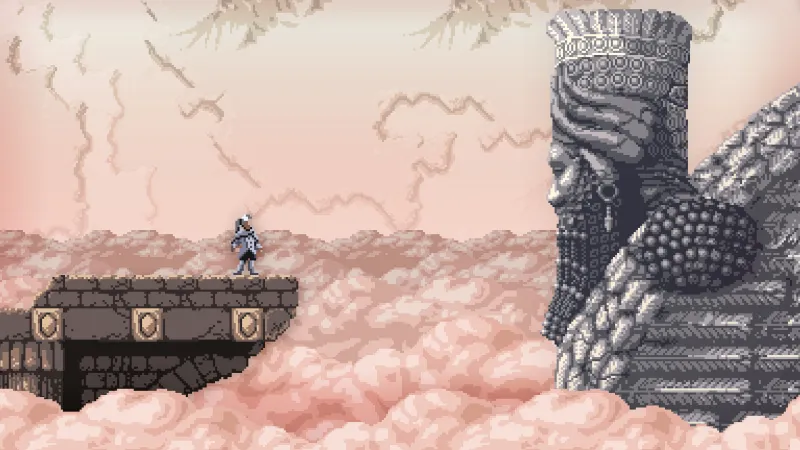
If you like Metroid, you’re in luck. Over the years, countless games have taken inspiration from Nintendo’s classic series, giving gamers an abundance of ways to explore connected maps, earn upgrades, and unearth secret items. But of all the projects that contain traces of Metroid DNA, 2015’s Axiom Verge came the closest to reconstructing it. The original Axiom Verge had a retro aesthetic, a lonely atmosphere, and an array of clever abilities that made the mysterious world a joy to traverse.
However Axiom Verge wasn’t a mere imitator; it built on a solid foundation with its own signature elements. A heady sci-fi story and mind-bending meta elements put a contemporary twist on the familiar formula – and with Axiom Verge 2, players are about to learn even more about this series’ unique identity. After five years of work by solo developer Tom Happ, this prequel/sequel hybrid is almost done, and I played the first few hours of an alpha version to see how the Axiom Verge universe is evolving.
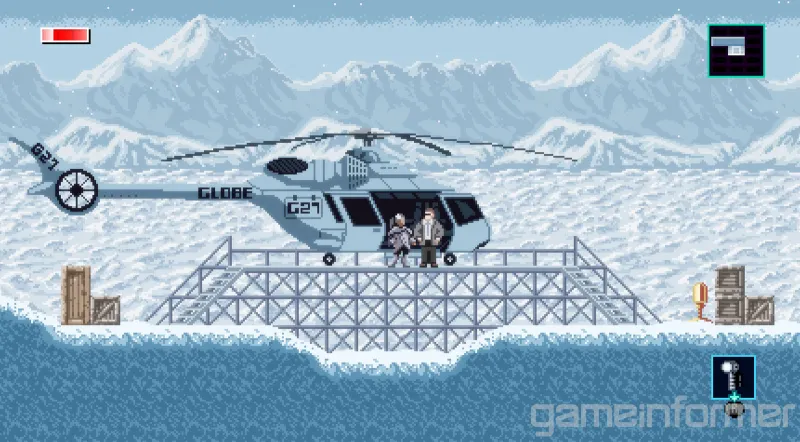
A COLD OPEN
“Come to Antarctica if you wish to see your daughter again.” That’s the message Indra Chaudhari sees when she turns on a prototype ansible – a device capable of faster-than-light communication. Indra is the founder and CEO of a conglomerate called Globe, and her organization recently inherited a defunct research station on the icy continent. So Indra heads south to explore the meaning of the mysterious message.
This backstory is explained during a brief scroll before I even choose “start game.” Though the story and characters are important to Axiom Verge 2, it isn’t a game that relies on cutscenes and lengthy exposition. Instead, I am put in control of Indra as soon as her helicopter lands, then set loose to start exploring Antarctica. The snow-covered ground, blue sky, and blowing flurries are a shift from the dark and alien corridors of the original Axiom Verge ... but the journey doesn’t stay tethered to our world for long.
After navigating the abandoned research station, Indra finds a secret room with what appears to be a normal freight elevator. But somewhere during that elevator ride, Indra crosses over into a different reality. Like protagonist Trace from the previous entry, she becomes a stranger in a strange land. But Indra’s land is strange in many new ways; the inhabitants are more intelligent, and the world is more seamlessly connected. Even Indra herself isn’t the same; after dying in this unfamiliar place, she is resurrected by a deific digital entity who was apparently confined to a nearby urn. This allows Indra to survive and continue her quest – and all this happens before you fight a single enemy.
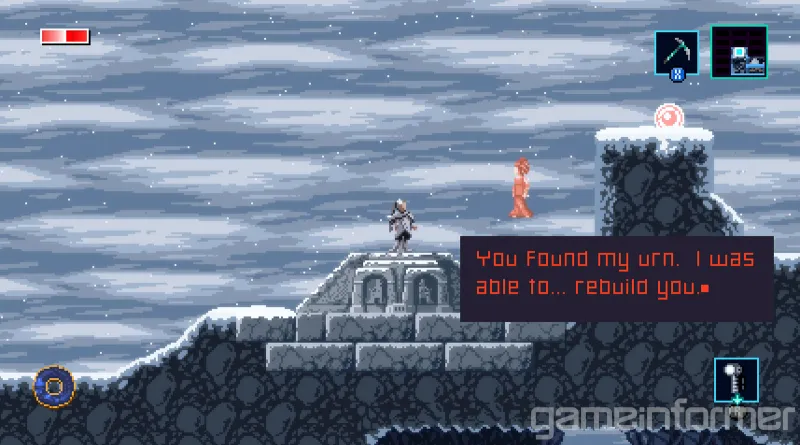
“One thing that’s different is where in Axiom Verge 1 you only ever see Trace’s life on Earth in cutscenes, in Axiom Verge 2 it takes you on the character’s journey from Earth into this other world, and then her subsequent transformation that leads into her gaining all these powers,” says developer Tom Happ. “So there isn’t any combat until then. It’s a bit like the intro to Link to the Past before you get the sword, or Super Metroid before you encounter Ridley. At the start I made it too long – there was a big robot blowing stuff up and you had no way to fight it – this only served to slow it down and also reduced the feeling of mystery.”
While this introductory sequence may still change between now and release, its current state successfully builds tension while introducing the basic premise and mechanics. Once Indra is rebuilt after her first death, though, the real adventure begins.
CLOSE COMBAT
If you’re familiar with games in the Metroidvania subgenre, you have a basic idea how the action progresses: You see an area you want to reach, but you can’t get there because of some obstacle, like a barrier you can’t break or a ledge you can’t reach. Then you get a new item or ability, and that allows you to explore previously inaccessible areas, where the cycle eventually begins again.
One of my favorite parts of the original Axiom Verge was how the barriers to progression didn’t just feel like “find the keycard for a locked door” scenarios. The items and abilities you acquired often affected your overall mobility and contributed to a sense of growing power. For example, when Trace gained the ability to phase through walls, it wasn’t just used once to reach one area; it opened up an array of new places across the map.
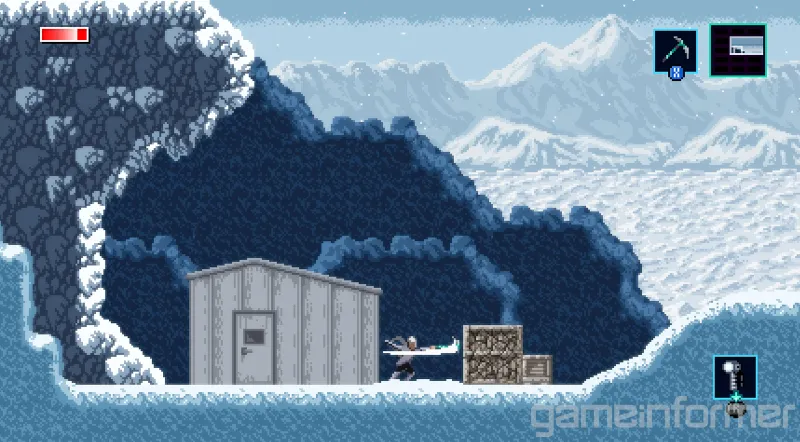
Axiom Verge 2 adheres to this satisfying model and adds its own surprises. Indra learns to grab ledges, climb walls, hack enemies, remotely control a drone, and more. I’m not going to run through every blockade and how I pushed through it during the three hours I played – especially since the sense of discovery is a big part of the fun. However, I am going to talk about the first weapon you find, because it represents an interesting new direction for Axiom Verge 2.
A short distance from the helipad – before she even crosses into the new world – Indra grabs an ice axe. She can swing this weapon to attack enemies and destroy objects such as wooden crates. It may seem like a basic tool, but the fact that the ice axe is a melee weapon has a major impact on combat, especially compared to the previous game.
In the original Axiom Verge, Trace’s initial weapon was a gun (the first of 25 players could acquire), which established his primary method of dealing with problems: He shot them. Similarly, Indra’s ice axe sets the tone for her approach. She does most of her damage at close range, which felt strange to me at first. Jumping into melee range to fight against lethal robots is more intense than firing safely at them from afar; I kept expecting to find a traditional gun that let me chip away at enemies from a distance, but the closest thing I got in the opening hours was a boomerang. That ranged weapon is useful, but a bit too slow and weak to fully substitute for something like Trace’s Axiom Disruptor.
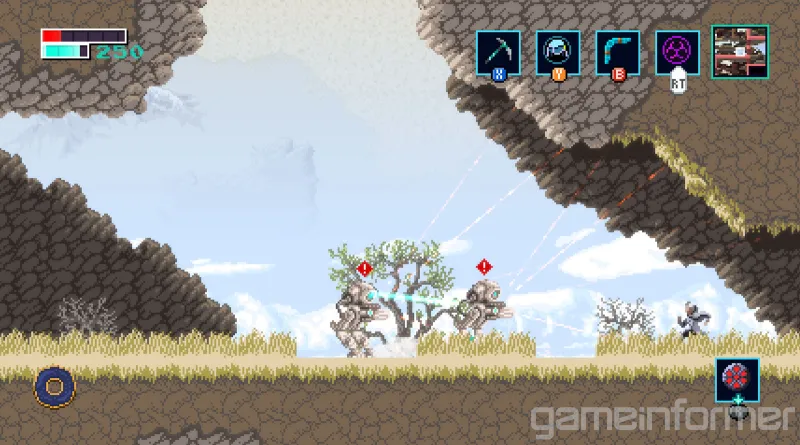
Though the ice axe isn’t Indra’s only offensive option, it certainly is her primary one early on. Even though you find other items, don’t expect to manage a sprawling arsenal, because Happ is implementing a smaller and more focused toolset for Axiom Verge 2. When asked about what drove that decision, he says: “One of the biggest criticisms of AV1 was that there were too many guns, so that definitely played a part. The other is that going with melee attacks, and the fidelity I wanted (you can attack in eight directions while standing, jumping, and crouching), there are a ton of animations that I had to pixel by hand.”
The other component that makes the melee combat more layered is the heightened intelligence of the foes you face. The hostile drones of Axiom Verge 2 aren’t confined to static and easily predictable routes, and many of them are able to detect and pursue Indra with surprising efficiency. They react to your presence in different ways; some charge you, some create distance, and some blast you with lasers. Learning these behaviors and adapting to them – especially when facing an encounter with a diverse assortment of enemies – makes combat feel dynamic and dangerous. But for Indra to succeed in her mission, you need more than an axe and a boomerang.
TOYS WITH A TWIST
Even with battles punctuating almost every step of the journey, the ways Indra moves through the world feel more important than the ways she fights its denizens. Axiom Verge 2 gives players a variety of ways to influence and explore their surroundings, leading to secret items, hidden shortcuts, and an overall sense of progression. Some of these may seem familiar if you played the original Axiom Verge, but a closer look reveals significant tweaks with major effects.
